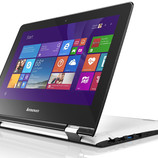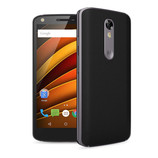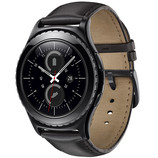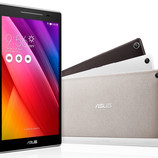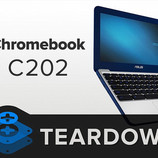Bad display choice? Lenovo's 11.6-inch convertible fails to impress in any given area - but it stands out in a negative way with its TN panel and limited viewing angle stability.
Test device courtesy of notebooksbilliger.de
Case & Connectivity
The chassis is made from two-tone plastic. The display lid and the bottom part of the base unit are white; all other parts are black. Three sides of the base unit are surrounded by a rubber bumper, which protects the upper base unit when the convertible is resting on it. The display can be rotated backwards a full 360 degrees to allow for different modes. The build quality is quite decent. As far as the sturdiness is concerned, the Yoga 300 exhbits the usual weaknesses: the chassis flexes in the areas next to the keyboard and below the touchpad. The base unit resists twisting quite well. To access the hardware, the bottom half of the base unit needs to be taken off, which is an easily accomplished job.
The small notebook features a decent number of ports. One of the three USB ports supports USB 3.0. HDMI out allows the user to connect a monitor or a TV. The physical ports are all located towards the rear on the left and right side.
The integrated card reader is about average as far as the speeds are concerned. Large data blocks are copied at a maximum transfer rate of 75.9 MB/s. The copy process of 250 jpeg-files (5 MB each) took place at 33.3 MB/s. For these tests we use our reference SD card Toshiba Exceria Pro SDXC 64 GB UHS-II.
Input Devices
Display
| |||||||||||||||||||||||||
X-Rite i1Pro 2
Maximum: 256 cd/m² Average: 241.6 cd/m²Brightness Distribution: 89 %
Center on Battery: 210 cd/m²
Contrast: 376:1 (Black: 0.68 cd/m²)
ΔE Color 8.87 | 1.01-23.34 Ø6.8
ΔE Greyscale 9.6 | 0.79-16.8 Ø7.1
55% sRGB (Argyll) 35% AdobeRGB 1998 (Argyll)
Gamma: 2.2
Screen Flickering / PWM (Pulse-Width Modulation)
| Screen flickering / PWM not detected | ||
In comparison: 53 % of all tested devices do not use PWM to dim the display. If PWM was detected, an average of 603 (minimum: 43 - maximum: 10420) Hz was measured.
| ||
Display Response Times
| ↔ Response Time Black to White | ||
|---|---|---|
| 24 ms ... rise ↗ and fall ↘ combined | ↗ 7 ms rise | |
| ↘ 17 ms fall | ||
| The screen shows good response rates in our tests, but may be too slow for competitive gamers. In comparison, all tested devices range from 0.8 (minimum) to 240 (maximum) ms. » 22 % of all devices are better. This means that the measured response time is better than the average of all tested devices (29.1 ms). | ||
| ↔ Response Time 50% Grey to 80% Grey | ||
| 58 ms ... rise ↗ and fall ↘ combined | ↗ 26 ms rise | |
| ↘ 32 ms fall | ||
| The screen shows slow response rates in our tests and will be unsatisfactory for gamers. In comparison, all tested devices range from 0.9 (minimum) to 92 (maximum) ms. » 89 % of all devices are better. This means that the measured response time is worse than the average of all tested devices (42.7 ms). | ||
Performance
The Yoga 300-11IBR is an 11.6-inch convertible notebook. The hardware is good enough for simple word processing and web browsing. Our review notebook sells for 380 Euro (~$430). Other versions are available as well with the price starting at 300 Euro (~$340).
Discussion
Processor
The Yoga 300 is equipped with an Intel Celeron N3050 (Braswell) dual-core processor with a clock speed of 1.6 GHz. The Turbo can overclock the cores up to 2.16 GHz. The CPU is quite frugal with a TDP of 6 watts, which in turn allows for passive cooling. The Celeron isn't exactly powerful and can't handle much more than simple word processing. During our benchmark runs, the CPU maintained the Turbo-maximum both with the notebook plugged in and running on battery power.
Cinebench R15 | Cinebench R10 | Geekbench 3 | Sunspider | JetStream 1.1 | Mozilla Kraken 1.1 | Octane V2 |Peacekeeper
Cinebench R15 | Cinebench R10 | Geekbench 3 | Sunspider | JetStream 1.1 | Mozilla Kraken 1.1 | Octane V2 |Peacekeeper
* ... smaller is better
System Performance
The system runs trouble-free and without any stutters. Potential buyers should be aware that the convertible was only designed to handle word processing and similar tasks. Common news and online-shop websites can take a little while to load. The results of the PC Mark benchmark tests reflect the performance of the integrated SoC. The convertible scores better than competitors with Bay Trail hardware thanks to the more powerful Braswell GPU. Swapping out the hybrid HDD for an SSD should improve the overall system performance.
| PCMark 8 Home Score Accelerated v2 |
| 1633 points |
| PCMark 8 Creative Score Accelerated v2 |
| 1650 points |
| PCMark 8 Work Score Accelerated v2 |
| 1295 points |
Help
| PCMark 8 - Home Score Accelerated v2 (sort by value) | |
| Lenovo Yoga 300-11IBR | |
| Acer Aspire One Cloudbook 11 AO1-131-C58K | |
| Lenovo Ideapad 100S 80R2 | |
| Acer Aspire ES1-131 | |
| Asus EeeBook X205TA-FD005BS | |
| Lenovo IdeaPad 300S-11IBR | |
Storage Device
The Aspire is equipped with a hybrid HDD from Seagate. The drive rotates at 5400 RPM and has a capacity of 500 GB. The included SSD cache (8 GB) increases the load speed of frequently-used applications. The transfer rates are equivalent to normal platter-based 5400 RPM drives.
GPU Performance
Intel's HD Graphics (Braswell) supports DirectX 12 and operates at speeds of up to 600 MHz. The results of the 3D Mark benchmarks are as expected for this particular GPU. The new graphics card is clearly better than the predecessor Bay Trail thanks to the new architecture.
An integrated decoder takes load of the processor during the playback of common video formats. The convertible can even handle H.265 (successor to H.264) 4K videos. When we ran our video (4k, H.265, 60 fps), the CPU load remained under 10 %. For our tests we used the movie and TV app Windows 10 comes with, as it supports hardware acceleration of H.265 videos.
| 3DMark 11 Performance |
| 434 points |
| 3DMark (2013) Ice Storm Standard Score |
| 14342 points |
| 3DMark (2013) Cloud Gate Standard Score |
| 1327 points |
| 3DMark (2013) Fire Strike Standard Score |
| 256 points |
Help
Gaming Performance
Users interested in gaming should stick with the casual games available from the Windows Store. Modern 3D games like Rise of the Tomb Raider are out of the question, since the hardware is simply not powerful enough.
| low | med. | high | ultra | ||
| BioShock Infinite (2013) | 22.1 | 11.4 | 9.6 | fps |
Emissions & Energy
System Noise
The SoC is passively cooled, so there is no fan system. The hard drive is audible, although we needed to pay close attention to hear it at all, as this particular model is very quiet. Swapping the HDD for an SSD would result in an utterly silent notebook.
Noise Level
| Idle |
32.4 / 32.5 / 32.5 dB(A)
| ||||
| HDD | 32.2 dB(A) | ||||
| Load | 32.5 / 32.4 dB(A) | ||||
30 dB
silent
40 dB(A)
audible
50 dB(A)
loud | |||||
min:
| |||||
Temperature
Speakers
Power Consumption
During idle, the convertible consumes a maximum of 7.8 watts - 3 watts less than than the netbook sibling. During the stress test, the power consumption increased to 16 watts, which is the same draw we measured under medium load. The reason is the throttling of both the CPU and the GPU performance during the stress test. The power adapter is rated at 45 watts.
Power Consumption
| Off / Standby | |
| Idle | |
| Load | |
| Key: min: | |
Battery Life
Our practically relevant WLAN test revealed a run time of 5 hours and 8 minutes. This result matches that of the Ideapad 300s-11IBR, which shut down after 5 hours and 15 minutes. For this test, we use the balanced profile and set the display to a brightness of 150 cd/m².
Battery Runtime
| WiFi Surfing v1.3 (Edge 25.10586.0.0) |
| 5h 08min |
Verdict
Lenovo Yoga 300-11IBR - 03/14/2016 v5
Sascha Mölck
Sascha Mölck
Convertible - Weighted Average









